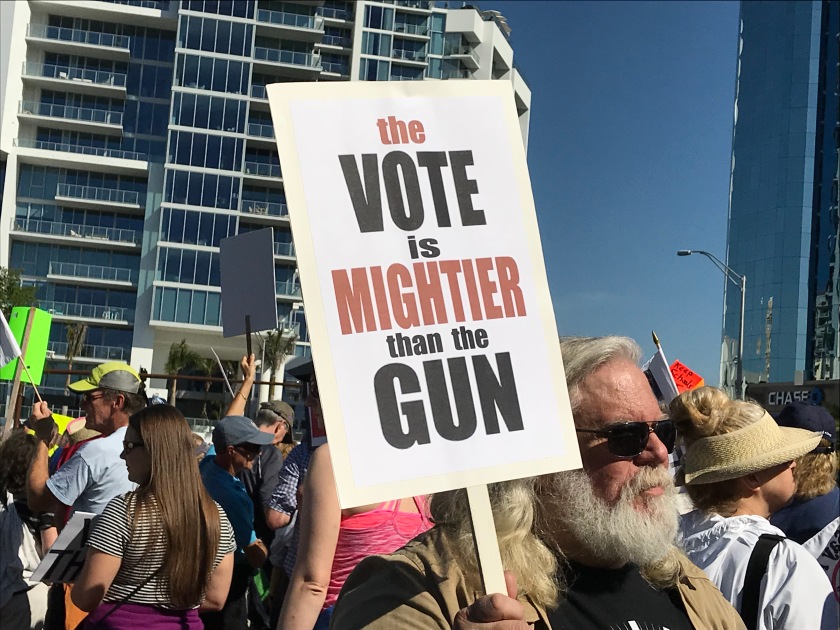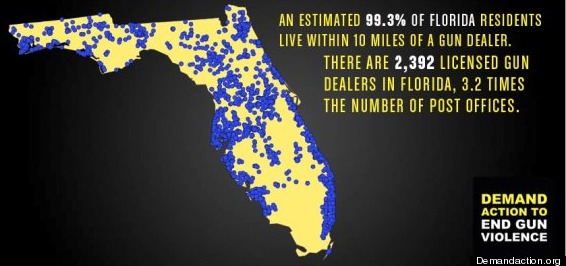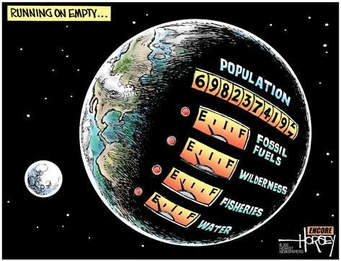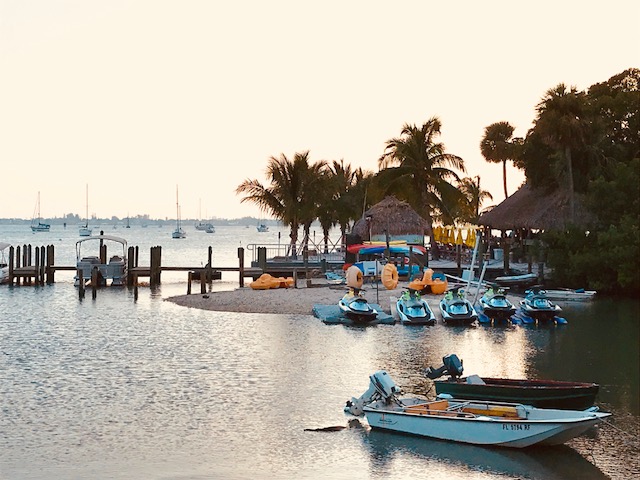Today, March 24, 2018, we joined citizens and communities throughout the country in demanding gun control. We were 20,000 strong in Sarasota.

All the “signs” are there that change will happen:









 Most articles on gun control start with the conclusion that guns either should be banned or shouldn’t be banned and then provide reasoning and evidence to support their position. In this article I will try to reverse that process and start with some facts and figures and then draw some conclusions.
Most articles on gun control start with the conclusion that guns either should be banned or shouldn’t be banned and then provide reasoning and evidence to support their position. In this article I will try to reverse that process and start with some facts and figures and then draw some conclusions.
Let’s start with the problem—gun-related deaths.
As everyone is aware, the U. S. leads the developed world in deaths related to guns (about 30,000 deaths per year).
What is sometimes missed because of the media’s focus on the sensational (e.g. mass killings) is that about 2/3rds of those deaths are from suicides. The most “successful” way of killing oneself is with the use of a gun, usually a handgun. Suicide attempts with guns result in deaths over 96% of the time. All other methods of attempting suicide are far less “successful,” none reaching even 10% success rates.
America is awash with guns.
America has about 4.4% of the world’s population but has about half of the world’s guns owned by civilians. There is more than one gun per person in the U. S., but actually most people (57%) live in households that are gun-free. Gun ownership is skewed with some people owning lots of guns and most people not owning any. 3% of Americans own almost half of all the guns in the country. 7.7 million people own, on average, 17 guns.
As one may suspect gun ownership is highest among white men (48%) and lowest among non-white women (16%). Why do people own them? According to polling 67% of the people who own them say they own them for “protection.”

What are people scared of?
Since Colonial times the crime rates have generally dropped. There have been occasional “up-ticks” in certain types of crime for various reasons, but generally the overall trend is down. In particular, since the 1990s all types of crime in the U.S. have declined.
However, over 60% of the American public actually believes that crime rates have increased in recent years.
Does arming people make them safer?
We often hear that countries with strict gun control have dramatically lower gun-related deaths than the U. S.—and that is true. What is seldom reported is that in developed countries with larger numbers of guns in circulation (even with strict gun control policies) the rates of gun-related deaths are higher than countries with fewer guns in circulation.
Even though crime rates have been declining, is it possible that crime rates in the U. S. are significantly higher than in other developed countries? That, also is not true. The U. S. actually has about an average amount per capita of crime compared with other developed nations.
States with tighter gun control laws have fewer gun-related deaths (e.g. Hawaii, NY, Mass, Iowa, RI) while states with more lax gun control laws have higher rates of gun-related deaths (e.g. Louisiana, Alaska, Miss, Alabama, Arkansas).
Some states have, over the last decade, enacted right to carry concealed gun laws. Those states have experienced a 13-15% increase in violent crimes compared to states that have no such laws.
Where is public opinion on the issue of gun control?
70% of Americans say they want stricter gun laws and among owners of guns 57% say they want stricter gun laws
89% of gun owners as well as non-gun owners say that the mentally ill should be prevented from purchasing a gun.
77% of gun owners say background checks should be mandatory for the purchase of a gun at gun shows.
77% of non-gun owners support a ban on assault weapons, but only 44% of gun owners support such a ban.

Will meaningful gun control be enacted?
Republicans who control all three branches of the federal government are overwhelmingly opposed to significant gun control measures. Democrats at the national level generally support stricter gun control measures.
States vary in their approaches with Democratically controlled states generally enacting stricter gun policies and Republican states going in the opposite direction (right to carry states).
In sum: Gun ownership is skewed with very few people owning most of the guns.
Conclusion—What can be done?
In a democracy government policies should follow the support of majorities unless those policies infringe upon the inherent rights of citizens. Yet, even then the Supreme Court has ruled that no right is absolute. Reasonable restrictions can and should be placed upon all rights. While the Court has ruled that individual citizens have a right to own guns, they also indicated that reasonable regulations are appropriate.
It would seem that greater regulation of guns is in order. Yet, in most states and at the national level this is not happening. Sadly, the major hurdle is the Republican Party, supported by (some would say captured by) the NRA. This was not always the case. All Republican presidents from Nixon to George W. Bush supported some form of gun control and Nixon actually wanted to ban all handguns.
If you want gun control today, and if it is a very important issue for you, then you are led to the conclusion that you cannot vote for any politician who refuses to support gun control—most likely not a Republican.
Where is Sarasota’s representative to Congress, Vern Buchanan, on gun control?
Buchanan is a member of the NRA and is “a strong defender of the Second Amendment.” He supports the right of individuals to carry concealed weapons across state lines, he wants to loosen the restrictions of interstate gun purchases, he wants to ban the registration of guns and trigger locks. He has “waffled” on banning bump stocks. If you are looking for measures to restrict access to guns Vern Buchanan is not your guy in Congress.
NOTE: A protest against the NRA and in favor of gun control will be held in Sarasota, Saturday March 24 from 10-noon at the Bayfront Park.

Yet another school shooting, but this time closer to home in Broward County, Florida. Television viewers are horrified at the film footage of children with raised arms running in a line from the school, of parents near hysterical as they search for their children, of law enforcement agents dashing about with raised rifles on a school campus; and of the 17 body bags.
The collective response of our lawmakers? “Ho-hum. You’ve got to understand that although it’s tragic, nothing can be done because we don’t want to politicize this tragedy.”
But of course there IS something they can do, and yes it is time to politicize these killings. It’s time to take on the National Rifle Association and to impose strict gun control laws. The Second Amendment is no defense for this lack of action because there is no constitutional right (think speech, religion, due process, press freedom, and yes the right to bear arms) that is absolute. Every right exists with limits (think libel laws, polygamy laws, age of majority laws, truth in advertising laws, and so on.) Every right is balanced by other rights; every right must be interpreted for the current time; and every right comes with responsibilities. If the Second Amendment must be viewed in absolutist terms, then it’s time to repeal it.
This Wild West gun culture is a death culture that is scarring and scaring the hell out of our children.
I grew up in the age of “duck and cover;” that is, when schools impressed on us the very real possibility of a nuclear attack by drilling us to run into the hallways and cower in a turtle posture until an all clear signal. So, one minute we are reading The Poky Little Puppy, and in the next, at the sound of an alarm, we are huddled on the floor waiting for either death or the all clear signal.
On the day that President John F. Kennedy was assassinated, I was in second grade and already well-versed in the Soviet threat to our survival. On the PA system, our Principal announced that the President had been shot and that our country was at risk of attack. School was canceled for the day, and we were told to run home as fast as we could, (no buses then; no caravan of parents waiting in cars).
What followed was a Brian De Palma-like slow-motion film segment of school doors opening to release a flood of screaming bobby-socked children who ran down the road from our school with lunch boxes and book bags flagging behind them. This phalanx then suddenly scattered as children fled in the various directions that lead to their homes.
The cluster of children from my street ran together and took to Pataki’s orchard, then ran through fields and wooded areas rather than risk being “captured” on the road by Soviet tanks. We ducked and covered at the sight of any airplane as we ran for our lives.
It was terrifying.
Today we have created a culture where students live with the real possibility of violence right in their place of learning–settings that should always be first and foremost safe places. So far in 2018, there have been 18 school shootings in the 45 days of 2018. (And that’s just the school shootings.) Isn’t that shocking?
Shouldn’t it shock us out of complacency that 438 people have been shot and 138 killed at schools since the Sandy Hook shootings of 2012? (https://www.nytimes.com/interactive/2018/02/15/us/school-shootings-sandy-hook-parkland.html)
Shouldn’t that rattle our political representatives to do something in response?
Isn’t it time to politicize (i.e., to pass legislation to address) these tragic moments?
So once you finish reading this, contact your representative of choice and rattle them: “Enough! DO SOMETHING!”

Once again we joined the March for Democracy and for Women in Sarasota. Last year the crowd was estimated at over 3,000. This year I’ll wager that it grew to over 4,000 (I was counted at 3,015 as I crossed the Ringling Bridge and there was a huge crowd behind me and in the park.)
Even some kayakers took to the water in protest.
Last year’s march was one of anguish the day after the Trump inauguration and people were consoled to find so many others who felt the same. This year’s march felt different; it was energized. It focused on taking action in the form of resistance, voting, support for progressive candidates, and work to overturn Trump’s actions and agenda. People supported causes: DACA, immigration, Planned Parenthood, the environment, LGBTQ rights, the ACA, peace not nukes, the news media, and democracy in general.
Here are some photos that capture the vibe of resistance (and even the sense of humor of many of the demonstrators):




Here in Florida we have viewed countless accounts of the freezing weather throughout the nation–but there has been hardly a word from the national news media about how we here on the Suncoast of Florida are suffering.
So here is my corrective to that lack of news coverage: It’s like brutally cold here and we are struggling, bigley!
 To begin, the temperature today ranged from the low 30s to a high of 54. That’s right, no fake news here, this is an actual photo of a thermometer in Sarasota, FL at 3:30 p.m. Horrifying, is it not?
To begin, the temperature today ranged from the low 30s to a high of 54. That’s right, no fake news here, this is an actual photo of a thermometer in Sarasota, FL at 3:30 p.m. Horrifying, is it not?

At lunch time today, outdoor cafes were frigid and we had to eat…INDOORS! It was like so crowded!
People were seen wearing not only closed toed shoes, but egads–SOCKS! And women covered-up in woolen shawls! And STILL they were cold!
The world’s No. 1 Beach, Siesta Beach, was…EMPTY!!! Unheard of!

Ignore that sunshine and blue sky, the pool was too CHILLY for swimming. Even Lido Beach closed their pool. Brrrrr!

There was a run on space heaters at Lowe’s, Home Depot, and Target! It was madness and survival of the fittest!
It reminded Karma of her days in Syracuse, NY, and Koda was glad to have his fur coat!

And in rare film footage, even Jack’s beloved Miata was seen tucked away in the garage with–HORRORS!–the top UP!
Keep us in your prayers, Nation. We survived Hurricane Irma, and we’ll use those skills to get through this as well.
 If you are a reader of the Sarasota Herald Tribune you have no doubt noticed that journalist Tom Lyons’ column is no longer a part of the paper. In August of 2017 Tom resigned. His column performed an important function in the community. In many ways he became the voice for those who were the victims of unfair treatment by government officials, bureaucrats, employers, HOAs, and other authorities. His column was based on a fundamental democratic cultural assumption (perhaps naïve) that if an injustice was made public community opinion would function as a corrective and force authorities to correct the problem. His simple stories illustrated that democracy was not about institutions (e.g. voting) as much as it was about cultural attitudes and beliefs.
If you are a reader of the Sarasota Herald Tribune you have no doubt noticed that journalist Tom Lyons’ column is no longer a part of the paper. In August of 2017 Tom resigned. His column performed an important function in the community. In many ways he became the voice for those who were the victims of unfair treatment by government officials, bureaucrats, employers, HOAs, and other authorities. His column was based on a fundamental democratic cultural assumption (perhaps naïve) that if an injustice was made public community opinion would function as a corrective and force authorities to correct the problem. His simple stories illustrated that democracy was not about institutions (e.g. voting) as much as it was about cultural attitudes and beliefs.
Lyons resigned because of personnel changes that he found unacceptable. Management at the paper made Lee Williams (a.k.a. The Gun Writer) the editor of Special Topics, in effect, making him Tom’s boss. Williams and Lyons “did not play well together” and Lyons decided to quit rather than work with him as his “boss.” He put it this way: “I have long had a strong personal antipathy for the man . . . assigned to become my supervising editor. The reasons for my feelings for the man may not matter. . . . Assigning this particular editor to me was a sharp stick in the eye.”
Many local government officials are most certainly breathing a sigh of relief knowing that Tom Lyons is not going to be second-guessing their decisions. Indeed the columnist who has replaced Tom, Carrie Seidman, has indicated that she will not be taking on the kinds of issues Lyons did. “My style is conversational, not confrontational, my focus on unifying rather than taking sides,” she wrote in her maiden column. But more than that, her columns are less about other people and more about her and her experiences. She writes about downtown flooding because she had to drive through a flooded intersection, she writes about the decline of newspapers because friends of hers are losing their jobs at them, she writes about racism after taking a walking tour of Newtown.
The contrast between Lyons and Seidman is stark. Lyons advocated for the person getting screwed and he identified exactly who was screwing him/her and he demanded answers. He used his column to offer a critical take on news stories and address issues behind the scenes that were not otherwise reported. Seidman is self-referential, and even when addressing situations of injustice fails to trace who the responsible authorities are who could solve the problems and instead concludes that somehow the royal “we” need to come up with solutions. It is the difference between exposés and taking a stance about abuses of power versus human interest stories that draw no conclusion.
I don’t know where Tom is today. My guess is he’s playing his guitar and fishing. In any case I miss his columns. He made Sarasota a better place (even though he never followed through on a couple of my “tips”), and given the state of American democracy today, a voice like his is needed more than ever.

One year ago Sarasota held a massive protest the day after Donald Trump was sworn in as President. This year we march again with the theme: Don’t Agonize! Organize!
So much to protest and so little time!
Saturday, January 20th
12-4 at Bayfront Park (gather near the Unconditional Surrender statue–ironic, no?)
Bring your signs! Resistance is NOT futile!
For more information or to spread the word:

Since taking office President Donald Trump has made a number of decisions to try to boost the carbon fuel industries. He has opened the door to oil drilling and coal mining on federally-owned lands in the West, he has repealed an Obama-era rule which restricted emissions from coal-fired plants, he has given the go-ahead for the completion of the Keystone XL Pipeline, and he put America on a path to withdrawing from the Paris Climate Change Accords. Opening ANWR in the Arctic to oil drilling is also now on the table. It’s full speed ahead for carbon-based fuels!
Encouraging and supporting these old sources of energy, of course, is a short-sighted approach which makes little or no sense if one wants to be a responsible steward of the Earth. Ultimately that approach, if unchecked, will lead to the end of civilization as we know it. Why? Simply because carbon-based energy is based on finite resources—inevitably we will, at some point, run out of them.
How close are we (the Earthly “we”) to moving from carbon-based energy to renewable energy sources? To address this question lets start by looking at places outside of the United States. Take Scotland for instance.
After Hurricane Maria devastated Puerto Rico it spun into the Atlantic and combined with Hurricane Lee (he got very little press) and headed toward the United Kingdom. When it reached Scotland there were sustained gale force winds which set the Scottish kilts and their wind turbines spinning—so much so that 99% of the country’s electrical power needs were generated for the month of October. Scotland could take advantage of the wind because they already had in place a green infrastructure. In fact, throughout the year Scotland produces 60% of its electricity from renewable sources.

Don’t have sustainable wind? No problem, look at what Wildpoldsried, Germany has done. In 1999 the town leaders made a commitment to produce all their electric energy with renewable sources by 2020. They developed a variety of green technologies including biomass, wind, solar, solar thermal, passive techniques for new construction, and hydropower. They exceeded their goals. By 2011 they were producing 321% of their energy needs and selling the excess for a nifty profit.
These aren’t the only places making advances. In 2016 Costa Rica ran on 100% renewable energy for 150 days of the year. Ten years ago Uruguay made a commitment to reduce its reliance on carbon-based energy; it now produces 95% of its electricity from renewables. And Iceland, which has incredible geothermal and hydropower resources, generates the most clean energy per person in the world which has helped transform its sluggish economy into a more diverse, vibrant economy that has attracted outside investors.
Where does the United States rank? The picture isn’t particularly pretty. In 2016 the U. S. generated less than 15% of its electricity using renewable energy. That puts us in the league with New Caledonia, Sao Tome and Principe (I didn’t even know that was a country), Macedonia, Belgium, Luxembourg, Japan, Haiti, and Mexico. We are behind a lot of countries we would like to compare ourselves to including Switzerland, Canada, Russia, Italy, China, Germany, France, Spain, and the United Kingdom. We are falling behind in what is clearly the future of energy production.
Here in Florida we have an obvious renewable resource—the sun. Our state’s nickname is “The Sunshine State” and we rank 5th nation-wide in sunshine per year (Arizona is number 1). That’s a lot of sun that could be turned into electricity. Unfortunately, our utilities produce only slightly over 2% of their electricity from renewable resources (and most of that is biomass). What is even more discouraging is that Florida Power and Light is presently asking the State Public Service Commission (PSC) permission to build yet another natural gas-fired plant! In terms of “solar friendliness” Florida ranks 26th, mainly because of backward state laws which fail to provide encouragement and incentives for the use of solar and a PSC which doesn’t force utilities to build non-carbon-based fuel plants. So ignore those TV commercials from FPL that tout its use of solar energy—they’re, at best, distortions. You can also ignore FPL’s claim that its rates are better than most states. In fact, the cost of energy in Florida is above the national average.
What can be done?
It seems clear that action to move toward using renewable energy sources should be a coordinated effort from the national, state, and local levels. Unfortunately, there is no significant leadership coming from the national level. States vary quite a bit with some, such as California, moving aggressively to green energy while others, such as Florida, putting their head in the sand. Local approaches also vary considerably and the problem, of course, is that they have fewer resources available to address it. Still, at all levels it is important to have political leaders who recognize the problem and adopt policies that encourage the use of renewable energy resources.
Our political elites have failed us on this issue. If change is to occur it must come from the grass-roots. Support environmental friendly groups, such as the Sierra Club which is opposing the FPL’s gas-fired plant. Write your representatives, and when they are up for election demand that they address the issue.
That sexual harassment is “news” makes me want to cry. The term “sexual harassment” was coined in the mid 1970s and appeared in the title of Lyn Farley’s book in 1978. Yes. Forty years ago.
And yet commentators and people who know some of the women coming forward are shocked, so shocked, that there exists two climates in the workplace: their own safe welcoming place versus a threatening climate about which they knew nothing. But now, they assure us, with so many women saying #metoo, things will change.
I doubt it.
The fundamental problem about sexual harassment is that victims (and I use the term deliberately as they are people who are targets of illegal activity) know that the risk of reporting it is greater than the risk of trying to appease the aggressor or to live with the harassment. It has been my experience that when a charge is made, the wheels of authority spin in favor of protecting the accused because the company or the institution has a stake in saying this didn’t happen or at least that they are not responsible (especially if this moves to court). The circling of the wagons of protection too often leave the woman on the outside.
Her isolation only increases when the people who were present and/or have knowledge about the incidents decide not to “take sides” or “get involved.” When asked to testify, when asked to back her up, when called upon for evidence, they claim to have seen no evil, heard no evil, and can’t even remember being present during the evil. This reluctance to speak should serve as evidence that the fear of retribution or targeting is real and reaches not only the victim but threatens those who know her as well. In this chilled “know nothing” climate, victims often have to go it alone.
As a result, the victim becomes “damaged goods,” a “trouble-maker,” and someone to be isolated and avoided. The women who bring the charges are known by a variety of names and none of them good: liars; ballbusters; teases; fantasizers; crazies; delusional bitches; femnazis (yes, remember that one?); frigid; overly sensitive; and those who just can’t take a joke.
So what exactly is the joke? It’s that women in the workplace have to laugh along when they (or other women) are touched, stroked, grabbed, shamed, threatened, kissed, or otherwise sexualized. They should play along when their heads are pushed down toward male crotches, should feel flattered when approached for sex, and should get the joke when men simulate having sex with them. And the funniest part is that men are entitled to do these things to women while at work. You would think that rather than side with these aggressors, those in authority at workplaces should be asking themselves what the hell is going on during the workday!
And as we hear from the famous women who are now coming forward with stories of how they refused these male aggressors, one has to wonder about other women: the ordinary women in the factory or office suite; the women who gave in to quid pro quo demands and feel too ashamed to speak out; the women who left jobs, graduate school, or professions because the way was blocked by a man who felt entitled to make sexual demands. Sexual harassment is illegal because it is serious: it shatters lives. It is a violation of equal protection of law because it undermines equality.
So, do we really need more sensitivity classes to explain to men who do these things why these actions are not only inappropriate but constitute ILLEGAL conduct? Do men really need to be instructed by a voice of authority to keep their pants zipped, their tongues in their mouths, and their hands to themselves? Do they need to be told in a seminar that women should be evaluated by their abilities, skills, and achievements, and not by whether they are willing to trade sex for a work opportunity?
Personally, I don’t think it’s a lack of education or sensitivity that needs to be addressed because it is arrogance, not stupidity that is the problem. What I want to see is enforcement of the laws that exist, and an important part of this structure is that others in the workplace react appropriately to these incidents and complaints.
Unbelievably but consistent with arrogance, many of these incidents occur with witnesses present. For those who see incidents of illegal behavior, intervention not blindness is called for. Say “stop it,” “don’t,” “not funny,” or “cut it out.” If someone brings a complaint, tell what you heard or saw. Help the victim by providing evidence in order to allow the process to work. Men and women have to make it clear that sexual harassment will not be kept a secret and thereby protected, but will instead be challenged and reported.
Administrators need to address sexual harassment the same way they do drug use on the job—zero tolerance. Rather than being unsure “who to believe,” complaints should be investigated and ultimately punished in proportion to the severity of the alleged action. Sexual harassment law allows for unintended mistakes (say, a touch to the shoulder or questionable joke) to be made and a warning issued. But a proven charge of quid pro quo (sex demanded for something), or an outright assault must be grounds for dismissal.
How many women have had their careers destroyed, their life course altered, and their self-esteem and bodies assaulted? We’ll never know, but enough already.






